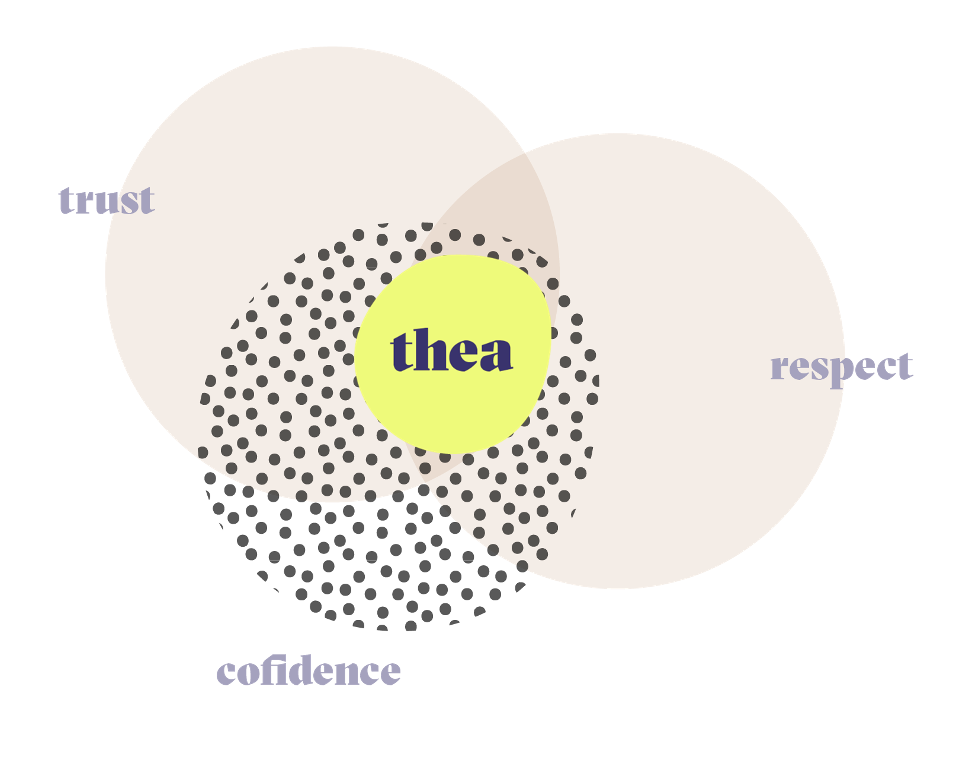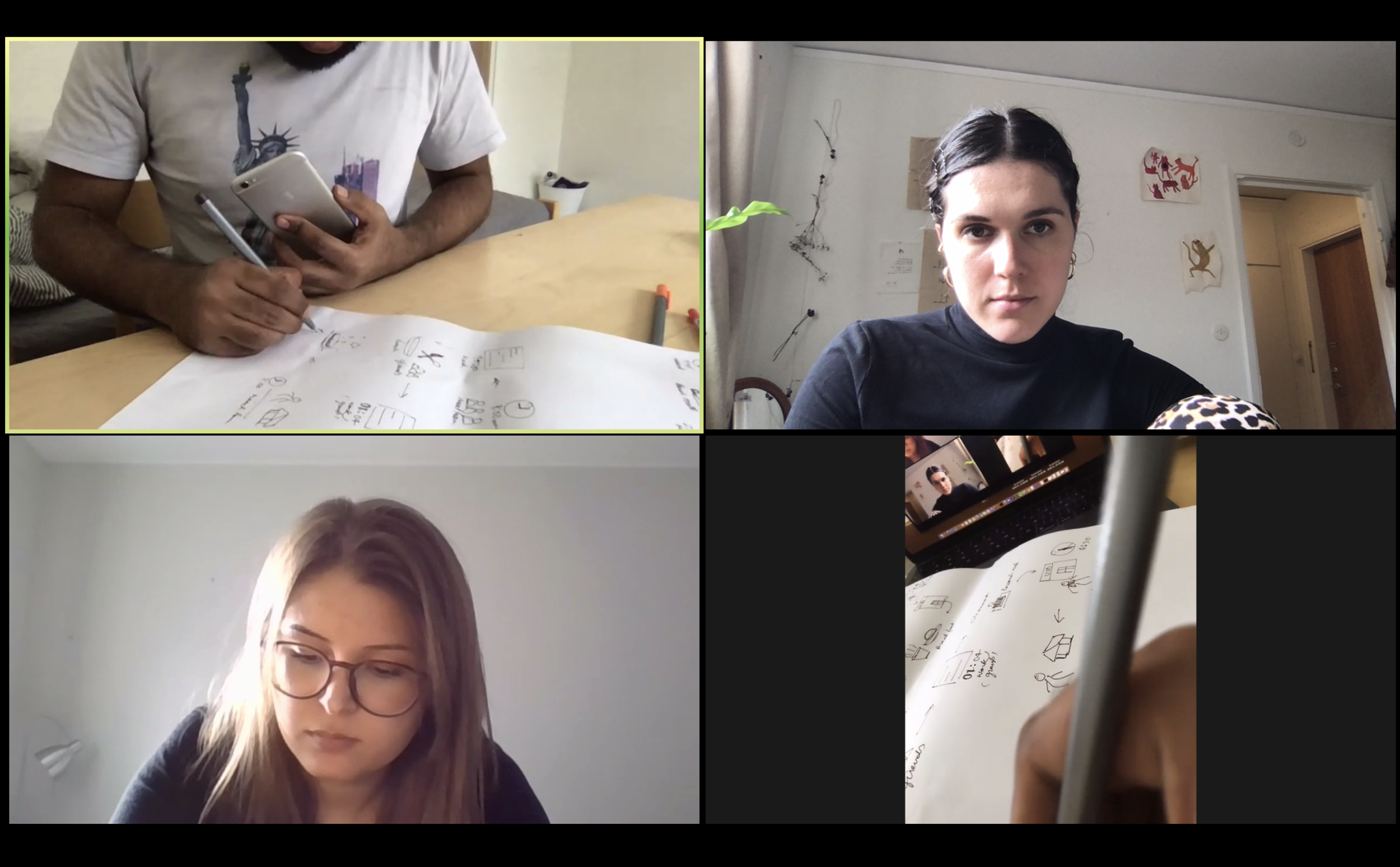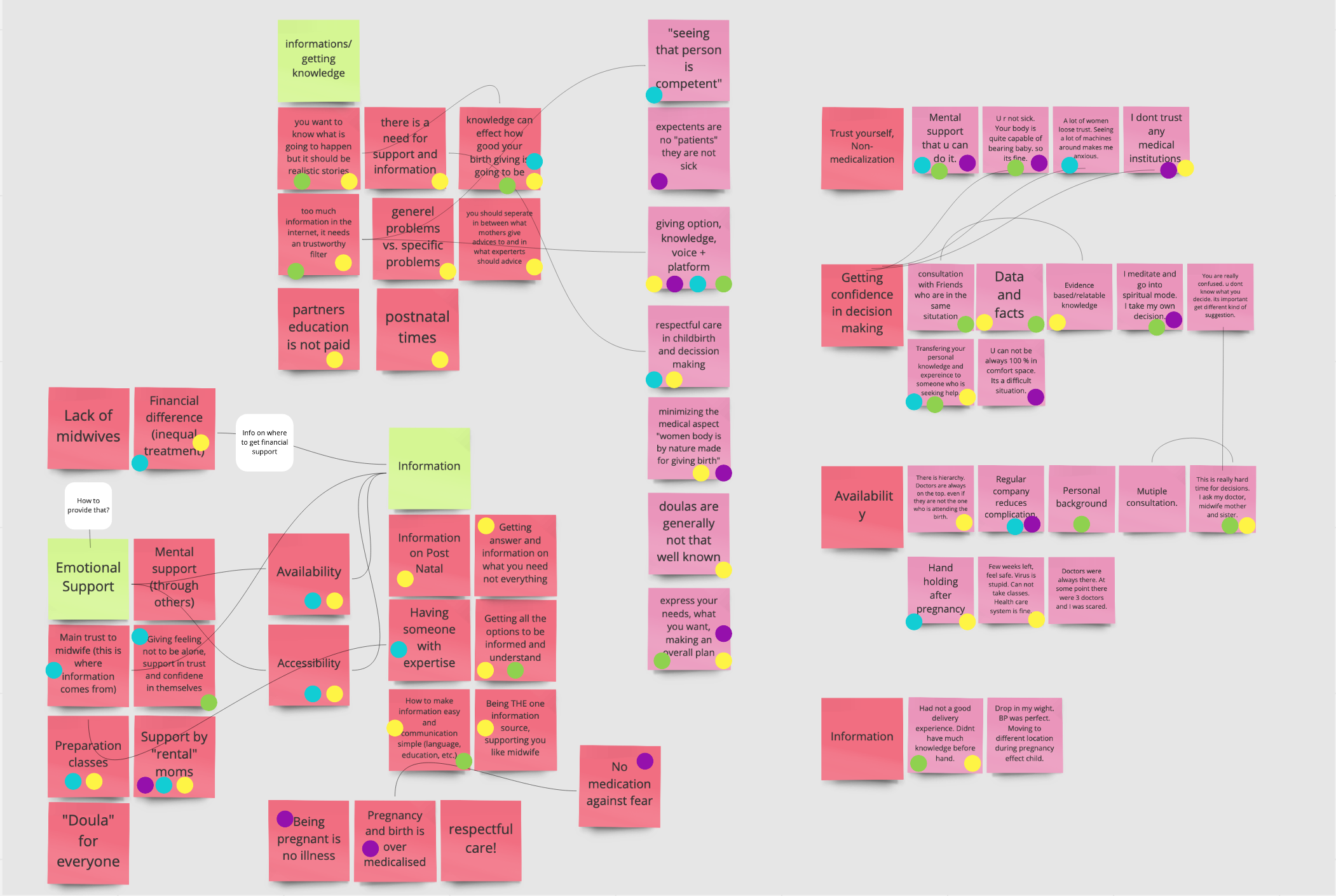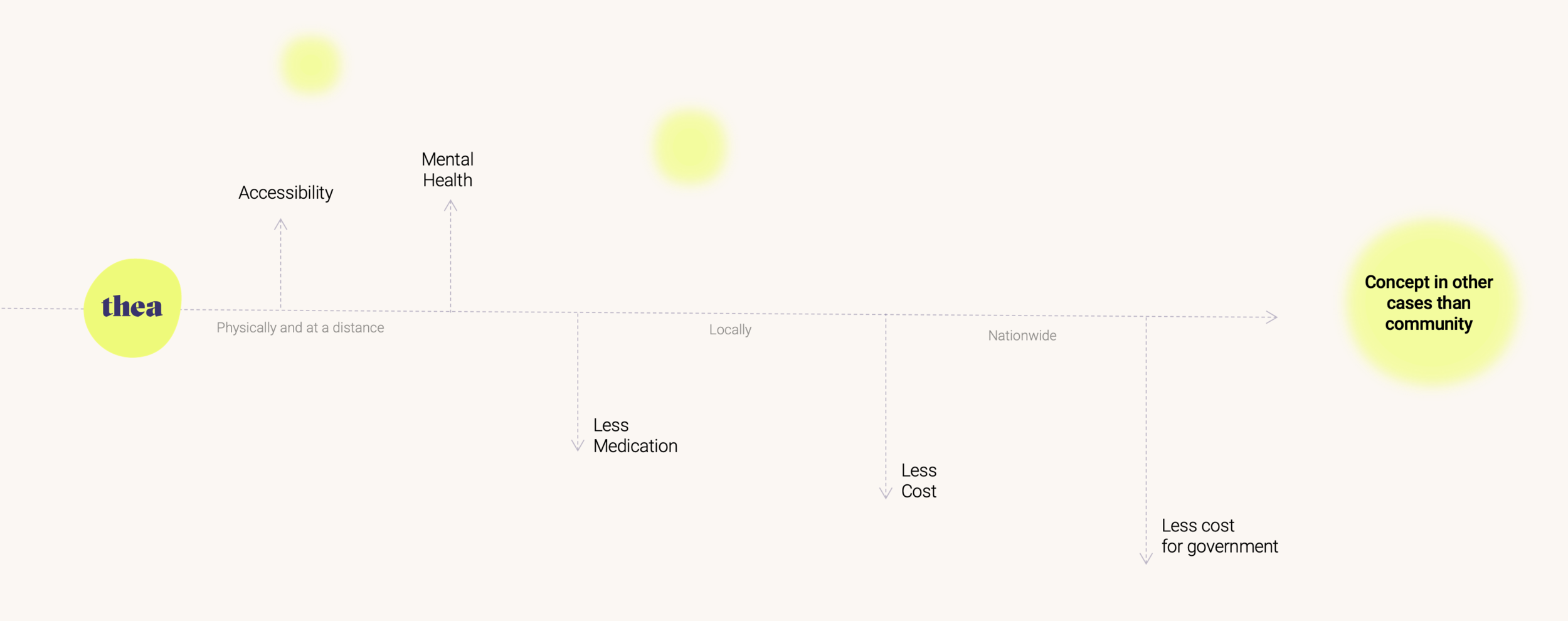
Building a Community of Support
Connecting and supporting the growth of a community of pregnant women, mothers, parents and care providers.
Thea helps building a community of support within parents and parents to be, which leads to trust in between and in themselves with a system consisting of a starting kit with the main information you need during pregnancy and labour, an app connecting you to a local community and additional information via social media.
Click here to find our remote workshop guide, developed during this project.
Course
General Product 2
2020 (10 weeks)
In collaboration with
Microsoft as a part
of Microsoft Expo 2020
Type
Service Design
Design Ethnography
Participatory Design
Co-Creation
Team
Regina Gensinger
Prithvi Ranjan
Role
Research
Workshops
Analysis
Brand Identity, Illustration
Storytelling
Challenge
The first brief allowed us to look into various directions “Togetherness at a distance” + “Design for a healthier Future”. With this broad perspective we gained in the co-creative research phase we then developed our very own brief. Developing a concept in co-creative sessions was especially challenging as we did not have the opportunity to physically meet participants, as a consequence of the pandemic Covid-19. We still managed to bring together mothers, midwives, doulas, etc. and create a service system with them, by living the brief “Togetherness at a distance”.
Outcome
Our project results in a service system determined by three parts: a starter kit, an app and support through social media. But the heart of everything, is actually about the aesthetics of a community. Help, support and trust that exist in a society. Our system design approach aims for the exchange of information and knowledge in a digital and physical environment, by connecting mothers or parents locally, but using professionals expertise from also further away, to help parents to take decisions with confidence.
Basic User Flow
Combines the three basic elements of the service system.
How does Thea work?
Receiving the Thea kit
The first touchpoint would be the care provider. This is where women receive their kit, which is meant to support an equal start into pregnancy, with important information, that is kept simple and understandable and available in different languages.
Getting an Invitation
In the kit (otherwise via social media) there is an invitation to join the Thea community. This can happen via the app, social media or physically in one of the local pregnancy societies.
Being part of the community
Through the app it is possible to see the latest news, organizing or being part of events and connecting to others as well as to midwives or doulas.
Blueprint
The blueprint gives a very detailed view of what stands behind the basic user flow, which is the part that is visible to the broad user group. For the blueprint we tried to consider emotions, but also add a the layer of what we want to achieve like: e.g. feel save or respect me.
As a first touchpoint we marked the care provider, this is where women receive the kit, next you would sign up for the app.
Thea Kit
The kit is providing you with the most important information for your pregnancy.
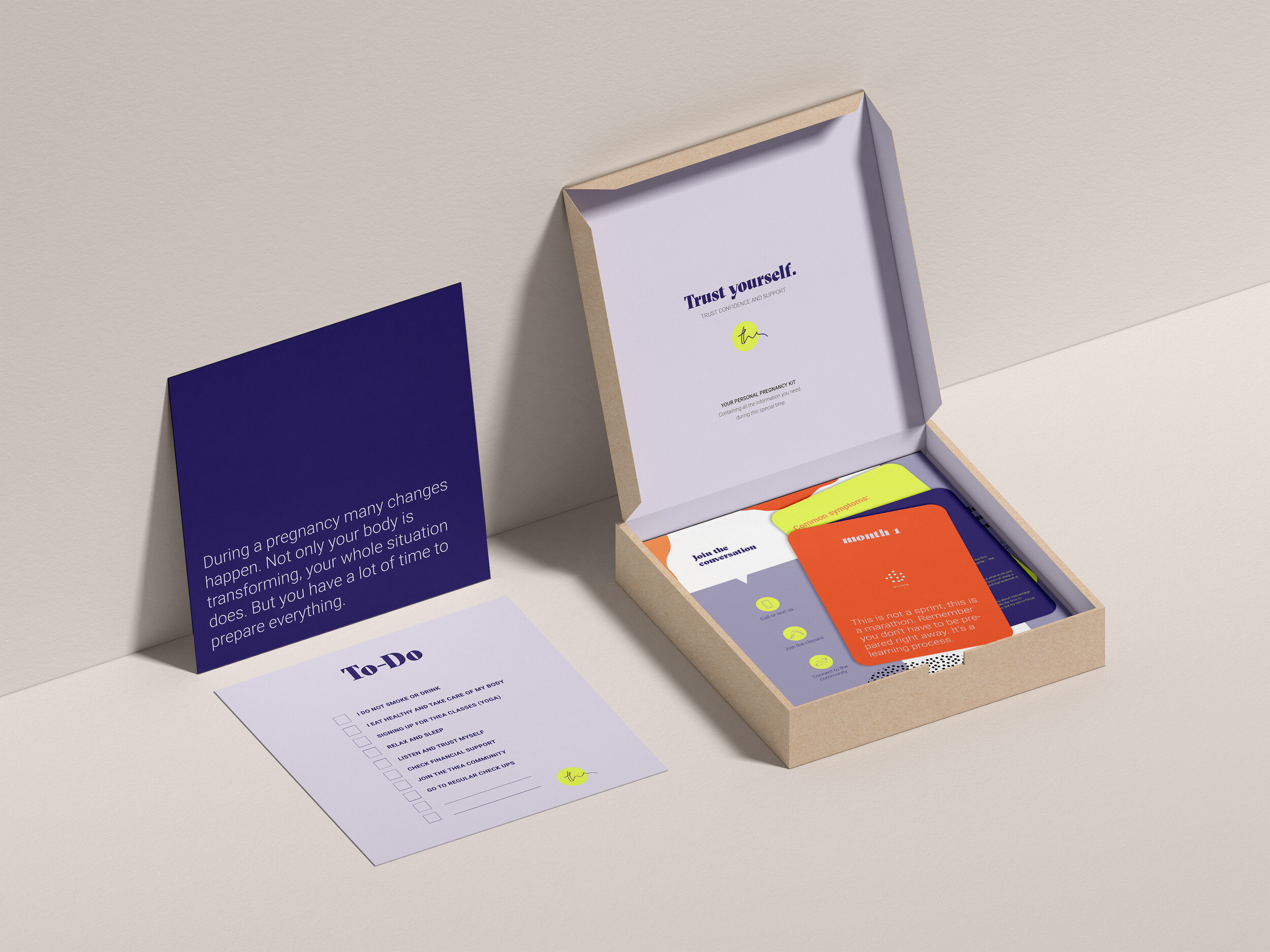
Kit Content
The kit is meant to be the first touchpoint to meet Thea and is supposed to help giving women a more equal start into pregnancy. It contains medical information, relaxing material, a to do list, something called the month cards, giving you more precise information on each month and most importantly the invitiation to join the local community.
To-Do
Ideas for pregnant women on what they should consider, like to take care of their body but also to get information on financial support opportunities or post natal care.
Diary
The pregnancy diary has been proven successful in many different countries. It gives to opportunity to document different stages of the journey.
Month Cards
There are month cards that give more specific information on each month of pregnancy, they are meant to show what common symptoms are and how to take good care.
Invitation
Important touchpoint for the user journey is the invitation that leads to either a physical meeting or to join via app.
Including Partners
It was very important to us to also include partners in the whole process and give them the opportunity to get an idea of what is happening to their partners body and how they can support them without being asked. Another aspect was to inspire them to get prepared for the whole journey as well as the birth process, as they often do not know what to expect.
Thea App
This part focuses especially on how to connect to other people.

App Functions
This part of the service system aims to exchange of information knowledge in a physical environment. We are focusing on providing the tools to talk about taboos, to have someone helping you to see options and then take decisions with confidence, someone who is close to you and that you can trust in yourself, also by coming back to someone.
The onboarding gives the opportunity to select different privacy settings.
The community is meant to grow and involve midwives, also from further away.
A second map is provided, mainly to show the most important information and help points.
Numerous Events are published and can be joined, as well as it is possbile to create an event.
There is a messaging platform implemented where you can directly reply to open questions or those in your contact map.
Media
Different Media platforms, like instagram or just normal posters are used.

Media Platforms
This is another way to get to know about Thea, via different media channels.
The main idea is to spread positive stories and true experience around the antenatal time. Social media can be a helpful tool to inform as it is also accessible to nearly everyone.
Process
remote design ethnography and participatory design
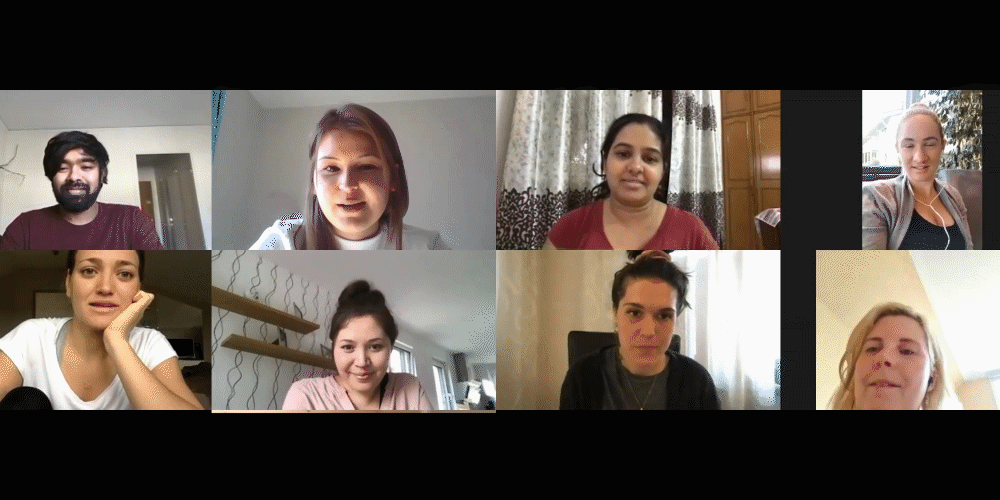
How we got there…
The concept of this course and therefore the project is based on a co-creative process, due to Covid-19 this had to happen remotely, which gave us the opportunity to use and learn new tools as we had to adapt to the given situation. We still managed to involve numerous participants who are the actual designers of this concept.
In our process we started very broad and then filtered and narrowed down to our final concept.
Problem Statement and Principles
Not only are child health consequences of poverty and pregnancy multiple, there are also many risks for preterm birth and neonatal or infant death. It is also proven that black women are 243 percent more likely to die from pregnancy or childbirth-related causes than are white women.
“How might we explore the trustworthy relationship midwives or doulas have to expectants, to translate those trust factors to improve confidence in themselves, with a more accessible care system?”
Phase 1: Design Ethnography
This phase was starting point of the project with many interviews and different interview methods, where we involved more than 10 health professionals and non professionals.
One day in a life
As we couldn’t follow our interviewees around in their homes we needed their support in documenting what they are doing during their days.
Health Item Diary
To get an idea of what people use and see as their very own health support we asked them to fill in a form of where they could describe that, this helped us understand for how many it is connected to mental health.
Journey Mapping
We used journey mapping to get insight on a typical day of health professionals.
Interview Overview
Trying to analyze all our interview insights, where especially the ones of the pregnant woman Vera and a young doctor stood out.
“I don’t really feel supported as there are not enough midwives. It’s so difficult to get reliable information, which causes a lot of stress for me and my pregnancy and I feel very insecure about my own and my babies health.”
Vera, 32

Phase 2: Participatory Design and Concept Study
After a detailed analysis of Phase 1 we were ready to further develop our co-creative methods to involve participants also in this phase of the project.
Exploration Workshop
In our Exploration Workshop we worked with six women, with very different backgrounds as we aimed to get a picture taken from various angles. Therefore we were happy that it was possible for us to invite a doula, two midwives, two pregnant women and a woman who just had a baby. All of them come from different countries which again helped us understand individual aspects. We developed three activities for the workshop session, our ethnographic kit.
With every new activity we tried to define new groups, with one of us in each of the groups as moderator and collector of the insights on the Miro board. The first activity was focusing mainly that everyone can introduce themselves and think and tell about an experience in health care that stood out for them.
Activity 2
We wanted to learn about their very individual experience during their pregnancy, birth and post-natal care. Hence we split up into groups so everyone has more freedom to talk about what they felt, saw and how they reacted.
Activitiy 3: Remote Café
Here we put them into different break-out rooms where we asked more specific questions like “What could a reliable system around pregnancy look like”. After five minutes we rotated and the new group built on what the others said before.
Testing our Methods on us
Before the sessions with outside participants we tried to test our activities ourselves. First to get a feeling on time and also to get to see what needs to be tuned.
Analyzing thoughts and ideas of our participants
We collected, connected and organized with different colours, as we could already see four key words standing out: decision making, information, emotional support and non medicalization. Those we tried to link and put in context with the health care system.
Main Insights

Ideation Workshop
In our ideation sessions we used co-creative methods where we involved one to two participants per session.
We prepared four activities as our kit for the session. Starting with a warm-up and finishing with a longer discussion. We decided to try smaller groups as we found it easier to learn more from each individual and elaborate together with them.
First we asked to visualize trust and confidence, as a warm-up and to start the conversation. As second activity we looked at different pictures and asked which one they associate with community. The third activity became more hands-on, we asked to draw, write or build their very own concept of the perfect experience with a community support system, related to pregnancy and suggested to try to include the drawing from activity 1 - how would trust and confidence be transferred?
In the session with the two participants they exchanged their concepts as activity 4, and used what they found relevant from the other’s concept, erased what they saw as critical and combined.
Also we used a lot of time for an open discussion.
“Giving support to other pregnant women - I would do that. Imagine being in South America, without your usual support around you…” Sara-Lisa, 27
“There should be the option of a physical space or online access to share and get information.” Kristina, 25
“You have to trust yourself, in order to give trust to others.” Isabel, 26
Co-Creation Findings

User Validation
Face to face feedback was unfortunately not possible because of the circumstances we were facing regarding the pandemic. We still managed to talk to our participants from our workshop sessions.
Explaining our starter kit to Cia, a midwife who supported us during the whole process.
Walking through the Thea app and explaining our concept of the Thea community.
“I get this warm feeling in my chest when I think of this is how the moms could connect.” (Cia, midwife)
Scalability
Thea is a concept for pregnant women and young parents, but the idea can be expanded into various directions.
Why not use and implement it for issues with mental health, aging society, alternative medicine, etc. This shows why such a concept is appealing for governmental funding as accessibility raises mental health, which leads into less medication and therefore less cost.

Our Teamwork
Even though it all had to happen remotely, as we were situated in Sweden and Austria, and really missed working in the same room, which can create an amazing work flow, we still managed to recreate that by switching from sessions we had together in Zoom, to individual ones. We had daily check-ins in the morning and afternoon to share ideas and findings as well as thoughts and concerns, and of course - most importantly: we couldn’t do without fika.




























